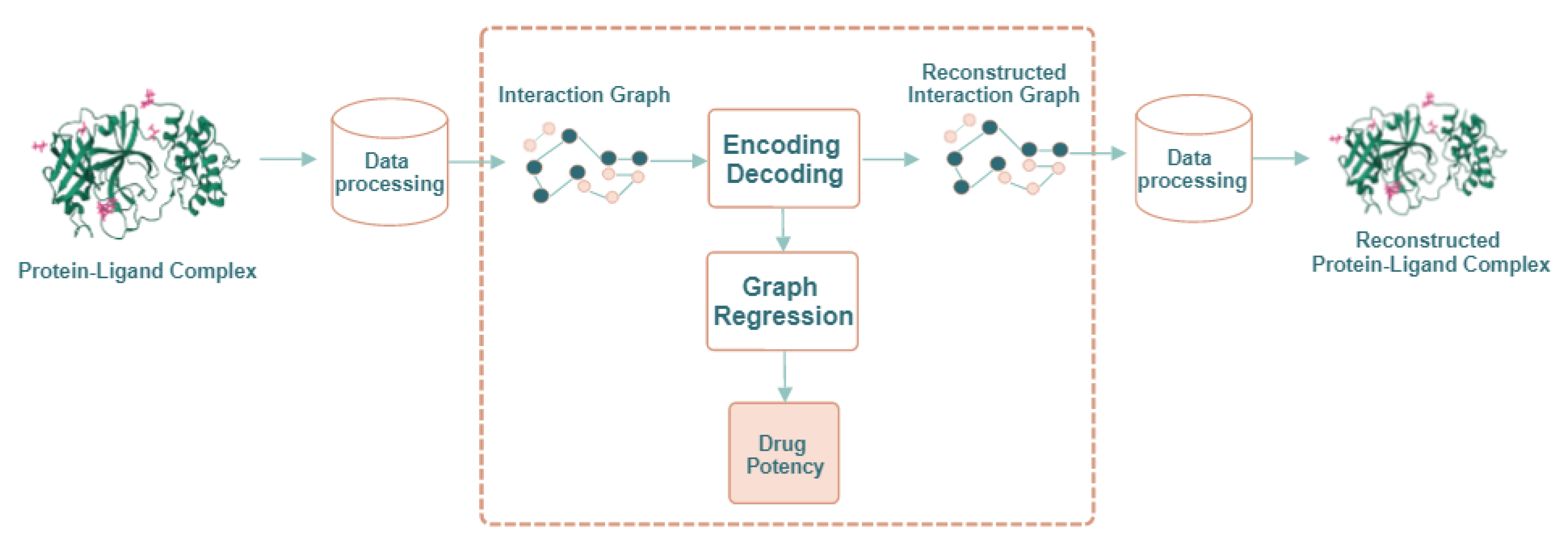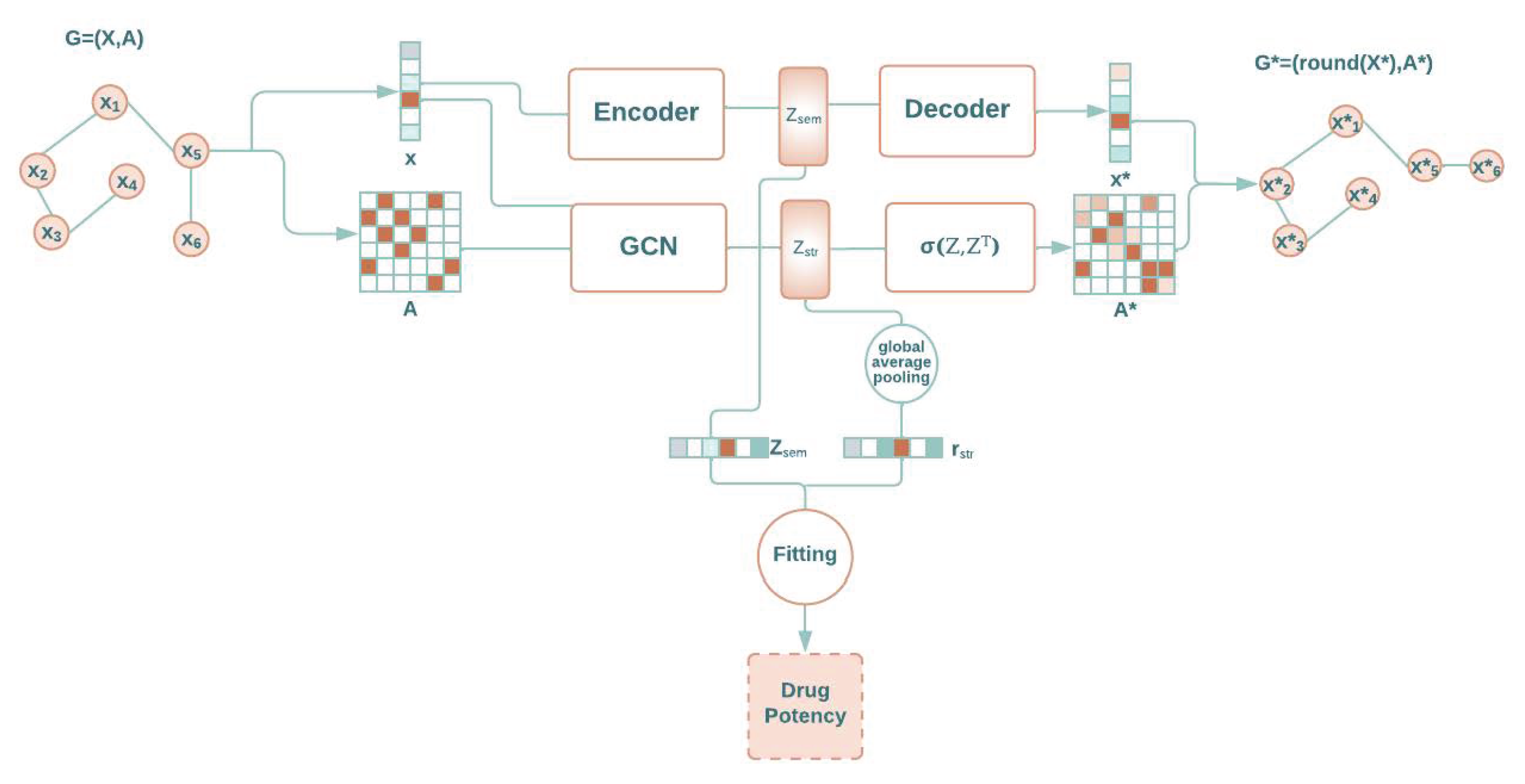Drug Potency Prediction of SARS-CoV-2 Main Protease Inhibitors Based on a Graph Generative Model
Abstract
1. Introduction
1.1. Autoencoders
1.2. Graph Autoencoders
2. Results and Discussion
2.1. Molecule Reconstruction
2.2. Drug Potency Prediction
2.3. Runtime Analysis
3. Materials and Methods
3.1. SARS-CoV-2 M-pro Database
3.2. Architecture Configuration
3.3. The Learning Process
4. Conclusions
Author Contributions
Funding
Institutional Review Board Statement
Informed Consent Statement
Data Availability Statement
Acknowledgments
Conflicts of Interest
Abbreviations
| GAE | Graph Autoencoder |
| GCN | Graph Convolutional Network |
| MSE | Mean Squared Error |
| VS | Virtual Screening |
Appendix A
| Source | Ligand Code |
|---|---|
| FRAGALYSIS | Mpro-x0689, Mpro-x0691, Mpro-x0755, Mpro-x0770, Mpro-x0830, Mpro-x10236, Mpro-x10322, Mpro-x10338, Mpro-x10371, Mpro-x10387, Mpro-x10417, Mpro-x10422, Mpro-x10423, Mpro-x10466, Mpro-x10535, Mpro-x10565, Mpro-x10638, Mpro-x10679, Mpro-x10789, Mpro-x10820, Mpro-x10870, Mpro-x10871, Mpro-x10876, Mpro-x10942, Mpro-x10959, Mpro-x11011, Mpro-x11271, Mpro-x11276, Mpro-x11294, Mpro-x11313, Mpro-x11317, Mpro-x11318, Mpro-x11366, Mpro-x11368, Mpro-x11454, Mpro-x11458, Mpro-x11488, Mpro-x11498, Mpro-x11499, Mpro-x11501, Mpro-x11507, Mpro-x11508, Mpro-x11530, Mpro-x11541, Mpro-x11542, Mpro-x11543, Mpro-x11548, Mpro-x11562, Mpro-x11564, Mpro-x11609, Mpro-x11612, Mpro-x11616, Mpro-x11641, Mpro-x11642, Mpro-x11723, Mpro-x11742, Mpro-x11743, Mpro-x11757, Mpro-x11764, Mpro-x11789, Mpro-x11790, Mpro-x11797, Mpro-x11798, Mpro-x11801, Mpro-x11810, Mpro-x11812, Mpro-x11813, Mpro-x11831, Mpro-x12000, Mpro-x12073, Mpro-x12143, Mpro-x12171, Mpro-x12177, Mpro-x12202, Mpro-x12207, Mpro-x12300, Mpro-x12321, Mpro-x12419, Mpro-x12423, Mpro-x12582, Mpro-x12587, Mpro-x12659, Mpro-x12661, Mpro-x12674, Mpro-x12679, Mpro-x12686, Mpro-x12692, Mpro-x12695, Mpro-x12696, Mpro-x12698, Mpro-x12699, Mpro-x12710, Mpro-x12715, Mpro-x12716, Mpro-x12731, Mpro-x12740, Mpro-x1336, Mpro-x1386, Mpro-x1418, Mpro-x2563, Mpro-x2572, Mpro-x2646, Mpro-x2649, Mpro-x2908, Mpro-x2910, Mpro-x2912, Mpro-x3303 |
| PDB | 6M2N, 6W63, 7AU4, 7B2J, 7B2U, 7B5Z, 7B77, 7E18, 7E19, 7KX5, 7L0D, 7L10, 7L11, 7L12, 7L14, 7LCT, 7LMD, 7LME, 7LMF, 7M8M, 7M8N, 7M8O, 7M8P, 7M8X, 7M8Y, 7M8Z, 7M90, 7M91, 7N44, 7N8C, 7NT3, 7O46, 7P2G, 7QBB, 7RLS, 7RM2, 7RMB, 7RME, 7RMT, 7RMZ, 7RN4, 7RNH, 7RNK, 7S3K, 7S3S, 7S4B, 7TVX, 7VIC, 7VLP, 7VLQ, 7VTH, 7VU6, 7VVP, 7VVT, 7X6K, 8ACD |
References
- Achdout, H.; Aimon, A.; Bar-David, E.; Morris, G.M. COVID Moonshot: Open Science Discovery of SARS-CoV-2 Main Protease Inhibitors by Combining Crowdsourcing, High-Throughput Experiments, Computational Simulations, and Machine Learning. bioRxiv 2020. [Google Scholar] [CrossRef]
- Owen, D.R.; Allerton, C.M.; Anderson, A.S.; Aschenbrenner, L.; Avery, M.; Berritt, S.; Boras, B.; Cardin, R.D.; Carlo, A.; Coffman, K.J.; et al. An oral SARS-CoV-2 Mpro inhibitor clinical candidate for the treatment of COVID-19. Science 2021, 374, 1586–1593. [Google Scholar] [CrossRef] [PubMed]
- Eastman, R.T.; Roth, J.S.; Brimacombe, K.R.; Simeonov, A.; Shen, M.; Patnaik, S.; Hall, M.D. Remdesivir: A Review of Its Discovery and Development Leading to Emergency Use Authorization for Treatment of COVID-19. ACS Cent. Sci. 2020, 6, 672–683. [Google Scholar] [CrossRef] [PubMed]
- U.S. Food and Drug Administration to Treat COVID-19. Available online: https://fda.gov/drugs/emergency-preparedness-drugs/coronavirus-covid-19-drugs (accessed on 20 March 2023).
- Gimeno, A.; Mestres-Truyol, J.; Ojeda-Montes, M.J.; Macip, G.; Saldivar-Espinoza, B.; Cereto-Massagué, A.; Pujadas, G.; Garcia-Vallvé, S. Prediction of novel inhibitors of the main protease (M-pro) of SARS-CoV-2 through consensus docking and drug reposition. Int. J. Mol. Sci. 2020, 21, 3793. [Google Scholar] [CrossRef]
- Macip, G.; Garcia-Segura, P.; Mestres-Truyol, J.; Saldivar-Espinoza, B.; Ojeda-Montes, M.J.; Gimeno, A.; Cereto-Massagué, A.; Garcia-Vallvé, S.; Pujadas, G. Haste makes waste: A critical review of docking-based virtual screening in drug repurposing for SARS-CoV-2 main protease (M-pro) inhibition. Med. Res. Rev. 2022, 42, 744–769. [Google Scholar] [CrossRef]
- Macip, G.; Garcia-Segura, P.; Mestres-Truyol, J.; Saldivar-Espinoza, B.; Pujadas, G.; Garcia-Vallvé, S. A review of the current landscape of SARS-CoV-2 main protease inhibitors: Have we hit the Bullseye yet? Int. J. Mol. Sci. 2021, 23, 259. [Google Scholar] [CrossRef]
- Siddiqui, S.; Upadhyay, S.; Ahmad, R.; Gupta, A.; Srivastava, A.; Trivedi, A.; Husain, I.; Ahmad, B.; Ahamed, M.; Khan, M.A. Virtual screening of phytoconstituents from miracle herb nigella sativa targeting nucleocapsid protein and papain-like protease of SARS-CoV-2 for COVID-19 treatment. J. Biomol. Struct. Dyn. 2022, 40, 3928–3948. [Google Scholar] [CrossRef]
- Chan, W.K.; Olson, K.M.; Wotring, J.W.; Sexton, J.Z.; Carlson, H.A.; Traynor, J.R. In silico analysis of SARS-CoV-2 proteins as targets for clinically available drugs. Sci. Rep. 2022, 12, 5320. [Google Scholar] [CrossRef]
- Gogoi, M.; Borkotoky, M.; Borchetia, S.; Chowdhury, P.; Mahanta, S.; Barooah, A.K. Black tea bioactives as inhibitors of multiple targets of SARS-CoV-2 (3CLpro, PLpro and RdRp): A virtual screening and molecular dynamic simulation study. J. Biomol. Struct. Dyn. 2022, 40, 7143–7166. [Google Scholar] [CrossRef]
- Deshmukh, M.G.; Ippolito, J.A.; Zhang, C.H.; Stone, E.A.; Reilly, R.A.; Miller, S.J.; Jorgensen, W.L.; Anderson, K.S. Structure-guided design of a perampanel-derived pharmacophore targeting the SARS-CoV-2 main protease. Structure 2021, 29, 823–833.e5. [Google Scholar] [CrossRef]
- Glaser, J.; Sedova, A.; Galanie, S.; Kneller, D.W.; Davidson, R.B.; Maradzike, E.; Del Galdo, S.; Labbé, A.; Hsu, D.J.; Agarwal, R.; et al. Hit expansion of a noncovalent SARS-CoV-2 main protease inhibitor. ACS Pharmacol. Transl. Sci. 2022, 5, 255–265. [Google Scholar] [CrossRef] [PubMed]
- Gao, S.; Sylvester, K.; Song, L.; Claff, T.; Jing, L.; Woodson, M.; Weiße, R.H.; Cheng, Y.; Schäkel, L.; Petry, M.; et al. Discovery and crystallographic studies of trisubstituted piperazine derivatives as non-covalent SARS-CoV-2 main protease inhibitors with high target specificity and low toxicity. J. Med. Chem. 2022, 65, 13343–13364. [Google Scholar] [CrossRef] [PubMed]
- Wang, L.; Wu, Y.; Deng, Y.; Kim, B.; Pierce, L.; Krilov, G.; Lupyan, D.; Robinson, S.; Dahlgren, M.K.; Greenwood, J.; et al. Accurate and reliable prediction of relative ligand binding potency in prospective drug discovery by way of a modern free-energy calculation protocol and force field. J. Am. Chem. Soc. 2015, 137, 2695–2703. [Google Scholar] [CrossRef]
- Li, Z.; Wu, C.; Li, Y.; Liu, R.; Lu, K.; Wang, R.; Liu, J.; Gong, C.; Yang, C.; Wang, X.; et al. Free energy perturbation–based large-scale virtual screening for effective drug discovery against COVID-19. Int. J. High Perform. Comput. Appl. 2023, 37, 45–57. [Google Scholar] [CrossRef]
- Li, Z.; Li, X.; Huang, Y.Y.; Wu, Y.; Liu, R.; Zhou, L.; Lin, Y.; Wu, D.; Zhang, L.; Liu, H.; et al. Identify potent SARS-CoV-2 main protease inhibitors via accelerated free energy perturbation-based virtual screening of existing drugs-19. Proc. Natl. Acad. Sci. USA 2020, 117, 27381–27387. [Google Scholar] [CrossRef]
- Kipf, T.N.; Welling, M. Semi-Supervised Classification with Graph Convolutional Networks. arXiv 2016, arXiv:1609.02907. [Google Scholar]
- Garcia-Hernandez, C.; Fernández, A.; Serratosa, F. Ligand-based virtual screening using graph edit distance as molecular similarity measure. J. Chem. Inf. Model. 2019, 59, 1410–1421. [Google Scholar] [CrossRef]
- Rica, E.; Álvarez, S.; Serratosa, F. Ligand-based virtual screening based on the graph edit distance. Int. J. Mol. Sci. 2021, 22, 12751. [Google Scholar] [CrossRef]
- Garcia-Hernandez, C.; Fernandez, A.; Serratosa, F. Learning the Edit Costs of Graph Edit Distance Applied to Ligand-Based Virtual Screening. Curr. Top. Med. Chem. 2020, 20, 1582–1592. [Google Scholar] [CrossRef]
- Zhou, J.; Cui, G.; Hu, S.; Zhang, Z.; Yang, C.; Liu, Z.; Wang, L.; Li, C.; Sun, M. Graph Neural Networks: A Review of Methods and Applications. arXiv 2018, arXiv:1812.08434. [Google Scholar] [CrossRef]
- Wu, Z.; Pan, S.; Chen, F.; Long, G.; Zhang, C.; Yu, P.S. A Comprehensive Survey on Graph Neural Networks. IEEE Trans. Neural Netw. Learn. Syst. 2021, 32, 4–24. [Google Scholar] [CrossRef]
- Le, T.; Le, N.; Le, B. Knowledge graph embedding by relational rotation and complex convolution for link prediction. Expert Syst. Appl. 2023, 214, 119122. [Google Scholar] [CrossRef]
- Kramer, M.A. Nonlinear principal component analysis using autoassociative neural networks. Aiche J. 1991, 37, 233–243. [Google Scholar] [CrossRef]
- Fadlallah, S.; Julià, C.; Serratosa, F. Graph Regression Based on Graph Autoencoders. In Proceedings of the Structural, Syntactic, and Statistical Pattern Recognition; Krzyzak, A., Suen, C.Y., Torsello, A., Nobile, N., Eds.; Springer International Publishing: Cham, Switzerland, 2022; pp. 142–151. [Google Scholar]
- Veličković, P.; Cucurull, G.; Casanova, A.; Romero, A.; Liò, P.; Bengio, Y. Graph Attention Networks. arXiv 2017, arXiv:1710.10903. [Google Scholar] [CrossRef]
- Mpro: Fragalysis. Available online: https://fragalysis.diamond.ac.uk/viewer/react/preview/target/Mpro (accessed on 20 March 2023).
- Majumdar, A. Graph structured autoencoder. Neural Netw. 2018, 106, 271–280. [Google Scholar] [CrossRef] [PubMed]
- Kipf, T.N. Deep Learning with Graph-Structured Representations. Ph.D. Thesis, University of Amsterdam, Amsterdam, The Netherlands, 2020. [Google Scholar]





| Autoencoder | GAE | ReGenGraph | |
|---|---|---|---|
| Mean | 0.83576 | 0.7456 | 0.6717 |
| Std. Dev. | 0.3188 | 0.9382 | 0.1796 |
Disclaimer/Publisher’s Note: The statements, opinions and data contained in all publications are solely those of the individual author(s) and contributor(s) and not of MDPI and/or the editor(s). MDPI and/or the editor(s) disclaim responsibility for any injury to people or property resulting from any ideas, methods, instructions or products referred to in the content. |
© 2023 by the authors. Licensee MDPI, Basel, Switzerland. This article is an open access article distributed under the terms and conditions of the Creative Commons Attribution (CC BY) license (https://creativecommons.org/licenses/by/4.0/).
Share and Cite
Fadlallah, S.; Julià, C.; García-Vallvé, S.; Pujadas, G.; Serratosa, F. Drug Potency Prediction of SARS-CoV-2 Main Protease Inhibitors Based on a Graph Generative Model. Int. J. Mol. Sci. 2023, 24, 8779. https://doi.org/10.3390/ijms24108779
Fadlallah S, Julià C, García-Vallvé S, Pujadas G, Serratosa F. Drug Potency Prediction of SARS-CoV-2 Main Protease Inhibitors Based on a Graph Generative Model. International Journal of Molecular Sciences. 2023; 24(10):8779. https://doi.org/10.3390/ijms24108779
Chicago/Turabian StyleFadlallah, Sarah, Carme Julià, Santiago García-Vallvé, Gerard Pujadas, and Francesc Serratosa. 2023. "Drug Potency Prediction of SARS-CoV-2 Main Protease Inhibitors Based on a Graph Generative Model" International Journal of Molecular Sciences 24, no. 10: 8779. https://doi.org/10.3390/ijms24108779
APA StyleFadlallah, S., Julià, C., García-Vallvé, S., Pujadas, G., & Serratosa, F. (2023). Drug Potency Prediction of SARS-CoV-2 Main Protease Inhibitors Based on a Graph Generative Model. International Journal of Molecular Sciences, 24(10), 8779. https://doi.org/10.3390/ijms24108779








